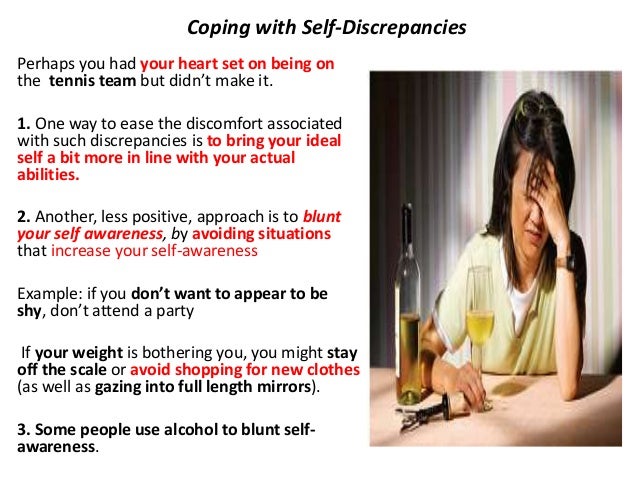What is self-image?
The real self is who we actually are. It is how we think, how we feel, look, and act. The real self can be seen by others, but because we have no way of truly knowing how others view us, the real.
- RealSelf Verified Doctors Millions have made us the leading online resource for finding top board-certified plastic surgeons and cosmetic treatment providers. Now we’re offering even more transparency by identifying those that meet our multistep professional and patient care requirements. Don't trust your beauty to just anyone.
- The ought self is how we perceive what other people want us to be. These kind of pressures can come from parents and relatives who are pushing you to be the best that you can be. If there is a strong difference between your actual self and your ought self it can lead to feelings of agitation, fear, anxiety, or guilt.
- Self-Discrepancy Theory is based on the notion that individuals experience psychological distress when a psychological distance exists between their actual and their ideal self. The theory was developed by Higgins in the 1980s. Over the years many different facets of the self or self-images have been identified.
Self-image is the personal view, or mental picture, that we have of ourselves. Self-image is an “internal dictionary” that describes the characteristics of the self, including such things as intelligent, beautiful, ugly, talented, selfish, and kind. These characteristics form a collective representation of our assets (strengths) and liabilities (weaknesses) as we see them.
How is self-image developed?
Self-image is a product of learning. Early childhood influences, such as parents and caregivers, have a major influence on our self-image. They are mirrors reflecting back to us an image of ourselves. Our experiences with others such as teachers, friends, and family add to the image in the mirror. Relationships reinforce what we think and feel about ourselves.
The image we see in the mirror may be a real or distorted view of who we really are. Based on this view, we develop either a positive or a negative self-image. The strengths and weaknesses we have adopted affect how we act today. We continually take in information and evaluate ourselves in several areas, such as physical appearance (How do I look?), performance (How am I doing?), and relationships (How important am I?).
With a positive self-image, we recognize and own our assets and potentials while being realistic about our liabilities and limitations. With a negative self-image, we focus on our faults and weaknesses, distorting failure and imperfections.
Self-image is important because how we think about ourselves affects how we feel about ourselves and how we interact with others and the world around us. Driver samsung for mac. A positive self-image can boost our physical, mental, social, emotional, and spiritual well-being. On the other hand, a negative self-image can decrease our satisfaction and ability to function in these areas.
How can we create a positive self-image?
Self-image is not permanently fixed. Part of our self-image is dynamic and changing. We can learn to develop a healthier and more accurate view of ourselves, thus challenging the distortions in the mirror. Self-image change occurs over a lifetime. A healthy self-image starts with learning to accept and love ourselves. It also means being accepted and loved by others.
Specific steps to develop a positive self-image
- Take a self-image inventory.
- Make a list of your positive qualities.
- Ask significant others to describe your positive qualities.
- Define personal goals and objectives that are reasonable and measurable.
- Confront thinking distortions.
- Identify and explore the impact of childhood labels.
- Refrain from comparing yourself to others.
- Develop your strengths.
- Learn to love yourself.
- Give positive affirmations.
- Remember that you are unique.
- Remember how far you have come.

What is body image?
Body image is part of self-image. Our body image includes more than what we look like or how others see us. It also refers to how we think, feel, and react to our own perception of our physical attributes.
Actual Self Products

Body image development is affected by cultural images and the influence of family, peers, and others. A positive body image contributes to enhanced psychological adjustment (less depression, positive self-worth, life satisfaction, less interpersonal anxiety, fewer eating disorders). Distortions in our thinking contribute to a negative body image.

Actual Self Psychology Definition
How can we enhance our body image?
Body image is not fixed. Our body experiences change as we grow older, and each stage in our life is associated with body image markers. Maintaining a positive body image is a lifelong process.
Changing negative body image means more than changing our body. It means changing how we think, feel, and react to our body. Weight management and surgery are two ways to alter the body. Learning to have a positive relationship with an imperfect body increases the ability to lose weight. Surgery can be a means for changing how we see ourselves. Extensive outside remodeling, however, also requires extensive inside changes in body image.
Actual Self
Specific steps to enhance body image:
Actual Self Psychology
- Explore your personal body image with its strengths and limitations.
- Confront thinking distortions related to your body.
- Challenge misleading assumptions about body appearance.
- Accept and love who you are.
- Be comfortable with your body.
- Have positive experiences with your body.
- Be a friend to your body with positive affirmations.
